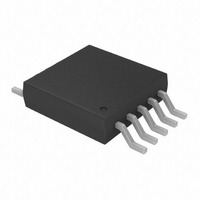TC665EUN Microchip Technology, TC665EUN Datasheet - Page 11

TC665EUN
Manufacturer Part Number
TC665EUN
Description
IC PWM FAN SPEED CTRLR 10-MSOP
Manufacturer
Microchip Technology
Type
Controller - SMBus Fan Speedr
Datasheet
1.TC664EUN.pdf
(36 pages)
Specifications of TC665EUN
Applications
Fan Controller, Brushless (BLDC)
Number Of Outputs
1
Voltage - Supply
3 V ~ 5.5 V
Operating Temperature
-40°C ~ 85°C
Mounting Type
Surface Mount
Package / Case
10-MSOP, Micro10™, 10-uMAX, 10-uSOP
Motor Type
PWM
No. Of Outputs
1
Output Current
5mA
Output Voltage
4.4V
Supply Voltage Range
3V To 5.5V
Driver Case Style
MSOP
No. Of Pins
10
Operating Temperature Range
-40°C To +85°C
Product
Fan / Motor Controllers / Drivers
Operating Supply Voltage
3 V to 5.5 V
Supply Current
300 uA
Mounting Style
SMD/SMT
Rohs Compliant
Yes
Lead Free Status / RoHS Status
Lead free / RoHS Compliant
Current - Output
-
Voltage - Load
-
Lead Free Status / Rohs Status
Lead free / RoHS Compliant
Available stocks
Company
Part Number
Manufacturer
Quantity
Price
Company:
Part Number:
TC665EUN
Manufacturer:
Microchip Technology
Quantity:
939
Company:
Part Number:
TC665EUN
Manufacturer:
MICROCHIP
Quantity:
12 000
Company:
Part Number:
TC665EUNTR
Manufacturer:
MICROCHIP
Quantity:
12 000
4.3
Often overlooked in fan speed control is the actual
startup control period. When starting a fan from a non-
operating condition (fan speed is zero RPM), the
desired PWM duty cycle or average fan voltage can not
be applied immediately. Since the fan is at a rest posi-
tion, the fan’s inertia must be overcome to get it started.
The best way to accomplish this is to apply the full rated
voltage to the fan for one second. This will ensure that
in all operating environments, the fan will start and
operate properly.
The TC664/TC665 devices implement this fan control
feature without any user programming. During a power
up or release from shutdown condition, the TC664/
TC665 devices force the V
cycle, turning the fan full on for one second (C
1.0 µF). Once the one second period is over, the
TC664/TC665 devices will look to see if SMBus or V
control has been selected in the Configuration Register
(DUTYC bit 5<0>). Based on this register, the device
will choose which input will control the V
Duty cycle control based on V
V
is connected to the V
default to a duty cycle of 39.33%. This sequence is
shown in Figure 4-4. This integrated one second star-
tup feature will ensure the fan starts up every time.
FIGURE 4-4:
4.4
As previously discussed, the TC664/TC665 devices
operate with a fixed PWM frequency. The frequency of
the PWM drive output (V
C
drive frequency is 30 Hz. This frequency can be raised,
by decreasing the capacitor value, or lowered, by
increasing the capacitor value. The relationship
between the capacitor value and the PWM frequency is
IN
F
Default PWM: 39.33%
2002 Microchip Technology Inc.
pin. With a 1 µF capacitor at the C
control is selected and the V
PWM Drive Frequency (C
Fan Startup
YES
Power Up or Release
One Second Pulse
V
Select SMBus
Cycle Control
IN
IN
from SHDN
V
PWM Duty
IN
Power-up Flow Chart.
pin), then the TC664/TC665 will
Open?
OUT
NO
NO
OUT
) is set by a capacitor at the
IN
output to a 100% duty
IN
is the default state. If
pin is open (nothing
YES
SMBus PWM Duty
F
Cycle Control
OUT
pin, the typical
F
)
duty cycle.
F
IN
=
linear. If a frequency of 15 Hz is desired, a capacitor
value of 2.0 µF should be used. The frequency should
be kept in the range of 15 Hz to 35 Hz. See Section 7.2
for more details.
4.5
The duty cycle of the V
controlled by either the V
Duty-Cycle Register, which is accessible via the
SMBus interface. The control method is selectable via
DUTYC (bit 5<0>) of the Configuration Register. The
default state is for V
and the V
to 39.33%. The duty cycle control method can be
changed at any time via the SMBus interface.
V
1.62 V to 2.6 V (typical) at this pin commands a 30% to
100% duty cycle on the V
voltage at V
cycle will not go below 30%. The relationship between
the voltage at V
Figure 4-5.
FIGURE 4-5:
Voltage, V
For the TC665 device, if the voltage at V
2.6 V (typical) level, an over temperature fault indica-
tion will be given by asserting a low at the FAULT output
and setting OTF (bit 5<X>) in the Status Register to a
‘1’.
A thermistor network or any other voltage output ther-
mal sensor can be used to provide the voltage to the
V
ally be thought of as a temperature. For example, the
circuit shown in Figure 4-6 represents a typical solution
for a thermistor based temperature sensing network.
See Section 7.3 for more details.
IN
IN
input. The voltage supplied to the V
is an analog input pin. A voltage in the range of
100
90
80
70
60
50
40
30
20
10
0
Duty Cycle Control (V
Cycle Register)
IN
1
IN
pin is open, the PWM duty cycle will default
IN
1.2
(Typical).
falls below the 1.62 V level, the duty
IN
1.4
and the PWM duty cycle is shown in
TC664/TC665
IN
1.6
control. If V
Input Voltage (V
PWM Duty Cycle vs. Input
OUT
OUT
IN
1.8
analog input pin or by the
PWM drive signal can be
output, respectively. If the
2
IN
2.2
IN
control is selected
DS21737A-page 11
)
IN
IN
IN
2.4
and Duty-
pin can actu-
exceeds the
2.6
2.8












